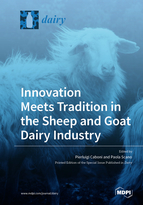Innovation Meets Tradition in the Sheep and Goat Dairy Industry
A special issue of Dairy (ISSN 2624-862X). This special issue belongs to the section "Dairy Small Ruminants".
Deadline for manuscript submissions: closed (15 June 2021) | Viewed by 26243
Special Issue Editors
Interests: food-omics; mass spectrometry; food safety; toxicology
Special Issues, Collections and Topics in MDPI journals
Interests: food; dairy; metabolomics; chemometrics; spectroscopy; mass spectrometry
Special Issues, Collections and Topics in MDPI journals
Special Issue Information
Dear Colleagues,
The domestic sheep (Ovis aries) and goat (Capra aegagrus hircus) are small ruminant species widely distributed throughout the world. They are raised in intensive or extensive production systems, usually on a smallholder farming system basis. Sheep and goat dairy products play an important economic role in many countries, particularly in the Mediterranean region, being closely linked to the culture and traditions of vast areas.
Today, traditional ovine and caprine dairy production chains, from farmers to exporters, are facing the challenges of innovation, sustainability, safety, and productivity, while at the same time protecting each product’s individual characteristics.
This Special Issue will welcome scientific contributions in the field of ovine and caprine dairy production with ground-breaking perspectives and approaches, from physical-chemistry studies on milk and dairy, to new feeding strategies, herd management, nutritional quality, animal welfare, sustainability, and omics studies.
Prof. Dr. Pierluigi Caboni
Prof. Dr. Paola Scano
Guest Editors
Manuscript Submission Information
Manuscripts should be submitted online at www.mdpi.com by registering and logging in to this website. Once you are registered, click here to go to the submission form. Manuscripts can be submitted until the deadline. All submissions that pass pre-check are peer-reviewed. Accepted papers will be published continuously in the journal (as soon as accepted) and will be listed together on the special issue website. Research articles, review articles as well as short communications are invited. For planned papers, a title and short abstract (about 100 words) can be sent to the Editorial Office for announcement on this website.
Submitted manuscripts should not have been published previously, nor be under consideration for publication elsewhere (except conference proceedings papers). All manuscripts are thoroughly refereed through a single-blind peer-review process. A guide for authors and other relevant information for submission of manuscripts is available on the Instructions for Authors page. Dairy is an international peer-reviewed open access quarterly journal published by MDPI.
Please visit the Instructions for Authors page before submitting a manuscript. The Article Processing Charge (APC) for publication in this open access journal is 1200 CHF (Swiss Francs). Submitted papers should be well formatted and use good English. Authors may use MDPI's English editing service prior to publication or during author revisions.
Keywords
- milk and dairy products
- dairy composition and chemical–physical properties
- food quality and safety
- omics sciences
- impact of process methods
- dairy microbiology
- animal feeding strategies
- animal welfare
- environmental sustainability







